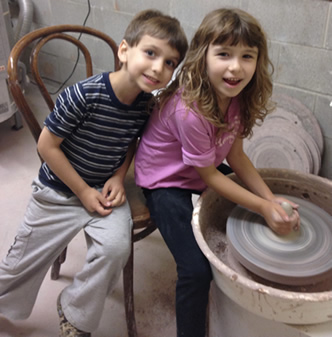 When I first started learning ceramics, my professor encouraged my classmates and me to make kiln gods for our glaze firing. This was an old tradition, he told us. We were going to position our greenware guardians near the kiln opening, just as the potters of ancient cultures did. The little gods would keep watch over our pieces during the firing.
When I first started learning ceramics, my professor encouraged my classmates and me to make kiln gods for our glaze firing. This was an old tradition, he told us. We were going to position our greenware guardians near the kiln opening, just as the potters of ancient cultures did. The little gods would keep watch over our pieces during the firing.
I remember the fun we had, fashioning those funky figures of good fortune. There was no way we couldn’t enjoy ourselves. The glaze firing was An Event, and excitement was in the air. We’d mixed our glazes, waxed and dipped our pots, cleaned and coated the kiln shelves, and planned our potluck party—all of this after weeks and weeks of producing our imperfect pinch pots, coiled pots, and slab constructions, plus the clumsy results of our attempts on the wheel. Clay work, we were realizing, was a great equalizer: Every newcomer to ceramics struggled. No matter how old we were, our pieces resembled a kindergartener’s. Never mind, though. We loved our pots. Our stubby kiln gods were similarly homely, not godlike at all, but playful (for we were playing) and fashioned with their endearing function in mind, how they’d protect our pieces as they faced the fire, ensure they endured unscathed the extreme temperatures, and deliver them to us intact and beautifully transformed.
Beautifully transformed: That’s exactly what happened, sometimes. A modest bowl dipped in copper red glaze, if it won a lucky location in the kiln where reduction and oxidation simultaneously discovered it, came out looking like a small miracle, half glorious orange-red, half vibrant pale green. Other times, bad things happened. Glazes dripped and crazed. Pots cracked. One or two pieces undoubtedly exploded. Those of us who have stuck with ceramics have learned ways to avoid some of these disappointing outcomes. We’ve also learned the limits of our preventative measures. It’s taken me almost thirty years of puttering with clay to accept that I can exercise only so much control. Disasters happen. But of course, so does magic.
In the beginning, however, we were forgiving of those cracks, drips, and bubbles. We admired our pieces regardless of their imperfections. We said things like, “This pot with the big crack on the bottom will make a perfect flowerpot.” We murmured wonderingly about a jewel tone, though the glossy glaze had dripped at the pot’s foot. We might have even half-liked that drip, how it felt when we touched it, how it was a testament to transformation, a reminder of the glaze’s once-liquid state. And we oohed and aahed over one another’s creations, brimming with goodwill and generous with our compliments.
After our potluck party, we tenderly wrapped our pieces in newspaper and tucked them carefully into cardboard boxes, delighted at the prospect of drinking our morning coffee out of our clunky cups, even if the cups were the size of shot glasses, and excited to give our family, friends, boyfriends, and girlfriends the pots that turned out best. We thought, thrillingly, that someday, we’d be good enough to make a bowl the size of a serving dish and then we’d fill it with a salad or dozens of cookies or Doritos, and how amazing potlucks would be then, when the food we contributed was passed around in our very own pots.
We didn’t pack up the kiln gods. They belonged to the kiln now, to future firings and future budding ceramicists—students who, like us, would fret over the fate of their fragile ware and appreciate the reassurances represented by talismans and charms.
When I think about my early pottery years, I remember the joy surrounding the occasion of that glaze firing. I learned a great deal in that first class and, since then, have accumulated a few more notions, not just about throwing pots but about artistic endeavors in general. For example, I think a lot about how creating comes from a pure place, a world of wonder, and how, since we make things with others in mind (those who will handle and gaze at what we painted, stitched, wove, performed, whittled, or sculpted, those who will listen to the stories we tell and read what we wrote), what we are making bear the essential attributes of gifts.
I think about that, too, when I’m on the receiving end of the creating. Sometimes I’m overwhelmed with tenderness, sensing the feeling that went into the crafting of something. Sometimes I cry. Does that make me sound silly? Then I’m silly. I don’t care. I hope I’m always overwhelmed in this way. I hope my heart stays soft and responsive to effort and earnestness. I hope I continue to feel the givingness of poems and prose and paintings and plays—and answer such gifts with gratitude. The impulse to make and share is a marvelous thing. May we marvel accordingly.

So beautiful!
Thank you, Diane! I appreciate that.
This post is a lovely “testament to transformation”, as you say, and underscores the value and necessity of such transformation within a supportive community. Just beautiful.
Victoria, what a kind comment! Thank you! You made my day.